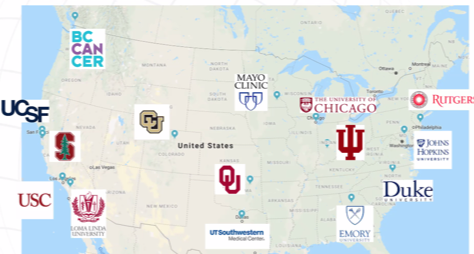Dr. Daneshmand began highlighting that the current standard of care for patients with node-positive seminoma is radiotherapy or chemotherapy without changes in these recommendations in many decades. However, these treatments are associated with significant long-term toxicity including secondary malignancies, cardiovascular disease, metabolic syndrome, and pulmonary toxicity. Given that patients with germ cell tumors are typically young at the time of diagnosis and treatment and have excellent cure rates, there are years of potential cumulative toxicity.

Thus, Dr. Daneshmand raised the question of whether there retroperitoneal lymph node dissection (RPLND) could be a potential treatment approach with lower rates of long-term morbidity. RPLND has known efficacy in treating germ cell tumors including in the primary treatment of stage I and IIa non-seminoma and in the post-chemotherapy setting for seminoma and non-seminoma with data demonstrating lower morbidity compared to chemotherapy and radiotherapy.
He highlighted early data demonstrating a potential for this approach, including results from four patients treated at his institution. At the time of publication, these patients were free of relapse at two years, though he highlighted that they have now been followed for at least 5 years without evidence of recurrence. From a technical perspective, Dr. Daneshmand commented that the dissection planes were normal and peri-operative outcomes were good with a mean length of stay of 3 days, minimal complications, and all patients maintaining antegrade ejaculation.
A subsequent review identified three other reports of RPLND in seminoma in which recurrence rates were generally favourable.

Further, he presented data from a survey of patients with CSII seminoma in which 77% demonstrated an interest in enrolling in a clinical trial of surgery in this disease space.
Thus, the SEMS trial (surgery in early metastatic seminoma) was launched as a phase II trial of RPLND as a first-line treatment in testicular seminoma with isolated retroperitoneal disease (1-3cm). The trial includes patients with pure testicular seminoma with stage I disease with retroperitoneal relapse or stage IIA/IIB disease. Patients must have lymphadenopathy of 1-3cm with no more than 2 lymph nodes present and these nodes within the RPLND template. The rationale for these limitations is that CT scan, in Dr. Daneshmand’s opinion, over under-estimates the burden of disease. Tumor markers were allowed to be no more than 1.5x the upper limit of normal and imaging must have been completed within 6 weeks of surgery. Patients were excluded if they had a history of other primary cancers, of chemotherapy, of radiotherapy, or with relapse more than 3 years following orchiectomy, due to potentially different biology.
Treatment was administered as an open, modified template RPLND. Robotic surgery was excluded in order to provide a more homogeneous intervention given the relatively limited sample size. Further to this point, surgeon credentialing was required with a minimum of 8 open RPLND in 1 year or 24 in 3 years. A modified template was mandated with surgeon discretion for wider dissection and intra-operative photographs for quality control were required.
The primary outcome is two-year recurrence-free survival with secondary outcomes of 5-year recurrence-free survival, pathologic upstaging, treatment-free survival, and complications from surgery.
The targeted sample size was increased to 55 from original estimates and this has been undertaken at a number of institutions across the US and in Canada.

Accrual proceeded ahead of schedule and closed early.
Prior to discussing the results of the SEMS trial, Dr. Daneshmand highlighted that PRIMETEST overlaps significantly, though patients with CSIIB disease and robotic surgical approaches are included.

Further, in addition to the aforementioned clinical outcomes, correlative studies looking that pre-operative PET-CT scan was included to compare with surgical mapping and better understand the role of PET-CT in primary seminoma.
Early safety outcomes including maximum accepted recurrent rates and rates of Clavien 3 or greater short-term complications were met allowing the trial to proceed.
The final results of this trial are due to be presented at ASCO-GU 2021. However, an interim analysis of 33 patients showed a median age of 34, with very good performance status (ECOG 0 in 94%), and a median follow-up of 2 years. Notably, 26% had relapsed following surveillance for CSI disease while the remainder presented with stage IIA/B disease. Short-term complications were uncommon with Clavien I-II events in 9% and Clavien III in 2 patients (3.6%).
He closed by emphasizing the rationale for RPLND as a primary treatment for seminoma given its known efficacy in germ cell tumors. Use in this disease space is aimed at reducing long-term treatment related toxicity and may represent a paradigm shift for treating metastatic seminoma. Future directions include a multicenter extension of the PRIMETEST trial as well as joint analysis of SEMS and PRIMETEST in addition to correlative work with miR371.
Presented by: Siamak Daneshmand, MD, Associated Professor of Urology, Director of Clinical Research, Keck School of Medicine of USC, University of Southern California, Los Angeles, CA
Written by: Christopher J.D. Wallis, MD, PhD, FRCSC, Instructor in Urology, Vanderbilt University Medical Center, Nashville, Tennessee Contact: @WallisCJD on Twitter during the 1st Global Society of Rare Genitourinary Tumors Virtual Summit, December 11-12, 2020


